Attached files
| file | filename |
|---|---|
| 8-K - 8-K - STATE STREET CORP | deutschebankmay2014-form8xk.htm |

The Way Ahead: Creating Long-Term Shareholder Value Joseph L. Hooley Chairman, President and Chief Executive Officer Deutsche Bank Global Financial Services Investor Conference May 28, 2014

2 Forward-looking Statements This presentation contains forward-looking statements as defined by United States securities laws, including statements relating to our goals and expectations regarding our business, financial and capital condition, results of operations, investment portfolio performance and strategies, the financial and market outlook, dividend and share repurchase plans, governmental and regulatory initiatives and developments, and the business environment. Forward-looking statements are often, but not always, identified by such forward-looking terminology as "plan," "expect,“ ”intend,” “forecast,” “outlook," "believe," "anticipate," "estimate," "seek," "may," "will," "trend," "target," “objective”, "strategy" and "goal," or similar statements or variations of such terms. These statements are not guarantees of future performance, are inherently uncertain, are based on current assumptions that are difficult to predict and involve a number of risks and uncertainties. Therefore, actual outcomes and results may differ materially from what is expressed in those statements, and those statements should not be relied upon as representing our expectations or beliefs as of any date subsequent to May 28, 2014. Important factors that may affect future results and outcomes include, but are not limited to: the financial strength and continuing viability of the counterparties with which we or our clients do business and to which we have investment, credit or financial exposure, including, for example, the direct and indirect effects on counterparties of the sovereign-debt risks in the U.S., Europe and other regions; increases in the volatility of, or declines in the level of, our net interest revenue, changes in the composition or valuation of the assets recorded in our consolidated statement of condition (and our ability to measure the fair value of investment securities) and the possibility that we may change the manner in which we fund those assets; the liquidity of the U.S. and international securities markets, particularly the markets for fixed-income securities and inter-bank credits, and the liquidity requirements of our clients; the level and volatility of interest rates and the performance and volatility of securities, credit, currency and other markets in the U.S. and internationally; the credit quality, credit-agency ratings and fair values of the securities in our investment securities portfolio, a deterioration or downgrade of which could lead to other-than-temporary impairment of the respective securities and the recognition of an impairment loss in our consolidated statement of income; our ability to attract deposits and other low-cost, short-term funding, and our ability to deploy deposits in a profitable manner consistent with our liquidity requirements and risk profile; the manner and timing with which the Federal Reserve and other U.S. and foreign regulators implement the Dodd-Frank Act, changes to the Basel III capital framework and European legislation, such as the Alternative Investment Fund Managers Directive and Undertakings for Collective Investment in Transferable Securities Directives, with respect to the levels of regulatory capital we must maintain, our credit exposure to third parties, margin requirements applicable to derivatives, banking and financial activities and other regulatory initiatives in the U.S. and internationally, including regulatory developments that result in changes to our structure or operating model, increased costs or other changes to how we provide services; adverse changes in the regulatory capital ratios that we are required or will be required to meet, whether arising under the Dodd-Frank Act or the Basel III capital and liquidity standards, or due to changes in regulatory positions, practices or regulations in jurisdictions in which we engage in banking activities, including changes in internal or external data, formulae, models, assumptions or other advanced systems used in the calculation of our capital ratios that cause changes in those ratios as they are measured from period to period; increasing requirements to obtain the prior approval of the Federal Reserve or our other regulators for the use, allocation or distribution of our capital or other specific capital actions or programs, including acquisitions, dividends and equity purchases, without which our growth plans, distributions to shareholders, equity purchase programs or other capital initiatives may be restricted; changes in law or regulation, or the enforcement of law or regulation, that may adversely affect our business activities or those of our clients or our counterparties, and the products or services that we sell, including additional or increased taxes or assessments thereon, capital adequacy requirements, margin requirements and changes that expose us to risks related to the adequacy of our controls or compliance programs; financial market disruptions or economic recession, whether in the U.S., Europe, Asia or other regions; our ability to promote a strong culture of risk management, operating controls, compliance oversight and governance that meet our expectations and those of our clients and our regulators; the results of, and costs associated with, governmental or regulatory inquiries and investigations, litigation and similar claims, disputes, or proceedings; delays or difficulties in the execution of our previously announced Business Operations and Information Technology Transformation program, which could lead to changes in our estimates of the charges, expenses or savings associated with the planned program and may cause volatility of our earnings; the potential for losses arising from our investments in sponsored investment funds; the possibility that our clients will incur substantial losses in investment pools for which we act as agent, and the possibility of significant reductions in the liquidity or valuation of assets underlying those pools; our ability to anticipate and manage the level and timing of redemptions and withdrawals from our collateral pools and other collective investment products; the credit agency ratings of our debt and depository obligations and investor and client perceptions of our financial strength; adverse publicity, whether specific to State Street or regarding other industry participants or industry-wide factors, or other reputational harm; our ability to control operational risks, data security breach risks and outsourcing risks, and our ability to protect our intellectual property rights, the possibility of errors in the quantitative models we use to manage our business and the possibility that our controls will prove insufficient, fail or be circumvented; dependencies on information technology and our ability to control related risks, including cyber-crime and other threats to our information technology infrastructure and systems and their effective operation both independently and with external systems, and complexities and costs of protecting the security of our systems and data; our ability to grow revenue, control expenses, attract and retain highly skilled people and raise the capital necessary to achieve our business goals and comply with regulatory requirements; changes or potential changes to the competitive environment, including changes due to regulatory and technological changes, the effects of industry consolidation and perceptions of State Street as a suitable service provider or counterparty; changes or potential changes in how and in what amounts clients compensate us for our services, and the mix of services provided by us that clients choose; our ability to complete acquisitions, joint ventures and divestitures, including the ability to obtain regulatory approvals, the ability to arrange financing as required and the ability to satisfy closing conditions; the risks that our acquired businesses and joint ventures will not achieve their anticipated financial and operational benefits or will not be integrated successfully, or that the integration will take longer than anticipated, that expected synergies will not be achieved or unexpected negative synergies will be experienced, that client and deposit retention goals will not be met, that other regulatory or operational challenges will be experienced, and that disruptions from the transaction will harm our relationships with our clients, our employees or regulators; our ability to recognize emerging needs of our clients and to develop products that are responsive to such trends and profitable to us, the performance of and demand for the products and services we offer, and the potential for new products and services to impose additional costs on us and expose us to increased operational risk; changes in accounting standards and practices; and changes in tax legislation and in the interpretation of existing tax laws by U.S. and non-U.S. tax authorities that affect the amount of taxes due. Other important factors that could cause actual results to differ materially from those indicated by any forward-looking statements are set forth in our 2013 Annual Report on Form 10-K and our subsequent SEC filings. We encourage investors to read these filings, particularly the sections on risk factors, for additional information with respect to any forward-looking statements and prior to making any investment decision. The forward-looking statements contained in this presentation speak only as of the date hereof, May 28, 2014, and we do not undertake efforts to revise those forward-looking statements to reflect events after that date.

3 Agenda Our Company Focused Strategy Financial Performance Summary The Way Ahead

Our Company
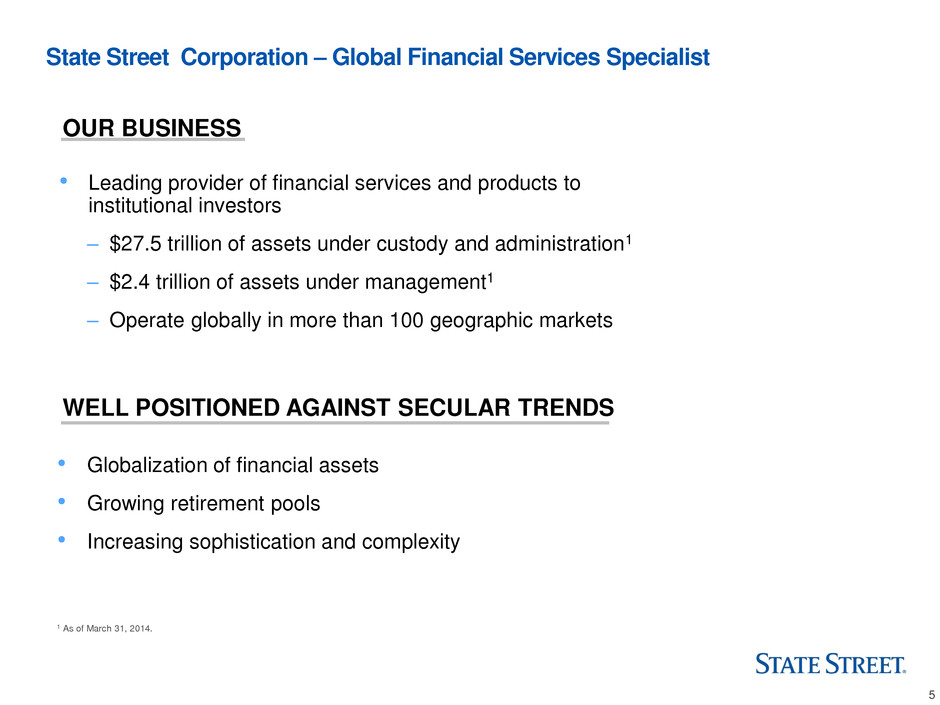
5 State Street Corporation – Global Financial Services Specialist OUR BUSINESS • Leading provider of financial services and products to institutional investors – $27.5 trillion of assets under custody and administration1 – $2.4 trillion of assets under management1 – Operate globally in more than 100 geographic markets • Globalization of financial assets • Growing retirement pools • Increasing sophistication and complexity 1 As of March 31, 2014. WELL POSITIONED AGAINST SECULAR TRENDS

Focused Strategy

7 1Goals presented on an operating basis, a non-GAAP presentation. See Appendix for explanations of our non-GAAP financial measures and for reconciliations of our operating-basis financial information. The Appendix is available on State Street’s website (www.statestreet.com/stockholder) and in State Street’s current report on Form 8-K filed with the SEC on the date hereof. Focused Strategy LONG-TERM SHAREHOLDER VALUE Operating-Basis1 Financial Goals: EPS Growth of 10-15%, Revenue Growth of 8-12% and ROE of 12-15% BUILDING ON OUR STRONG CORE ACHIEVING A DIGITAL ENTERPRISE INVESTING IN OPPORTUNITIES FOR GROWTH OPTIMIZING CAPITAL Aligning solutions with client needs, continuing to innovate, capturing value and improving efficiency Driving greater transformation that benefits clients and our shareholders Acting on changes in the market to fuel expansion of products and services and the markets we serve Adapting to new rules and optimizing returns for shareholders TALENT, CULTURE AND INNOVATION

8 Data as of, or for the quarter ended March 31, 2014, as appropriate. Focused Strategy – Building on our Strong Core Transitioning to a more integrated sales approach by sector Capturing full value of client relationships Developing innovative new products and services Leveraging technology leadership for speed and efficiencies Focusing on fast-growing markets KEY DEVELOPMENTS AMERICAS ● AUC/A: $20.54T ● Revenue: $1.44B ● AUM: $1.48T EUROPE, MIDDLE EAST, AFRICA ● AUC/A: $5.70T ● Revenue: $834M ● AUM: $562B ● AUC/A: $1.23T ● Revenue: $209M ● AUM: $339B Data as of December 31, 2012. ASIA-PACIFIC Extensive Global Footprint Our Powerful Global Franchise Sets Us Apart in Meeting the Needs of Institutional Investors
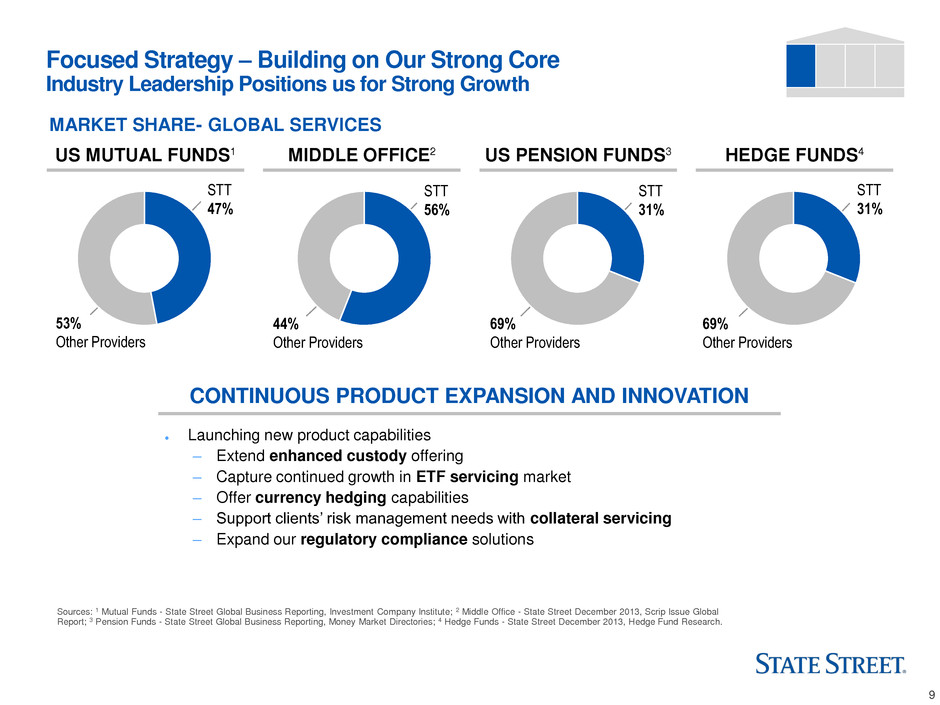
9 US MUTUAL FUNDS1 MIDDLE OFFICE2 US PENSION FUNDS3 Sources: 1 Mutual Funds - State Street Global Business Reporting, Investment Company Institute; 2 Middle Office - State Street December 2013, Scrip Issue Global Report; 3 Pension Funds - State Street Global Business Reporting, Money Market Directories; 4 Hedge Funds - State Street December 2013, Hedge Fund Research. Focused Strategy – Building on Our Strong Core Industry Leadership Positions us for Strong Growth ● Launching new product capabilities – Extend enhanced custody offering – Capture continued growth in ETF servicing market – Offer currency hedging capabilities – Support clients’ risk management needs with collateral servicing – Expand our regulatory compliance solutions CONTINUOUS PRODUCT EXPANSION AND INNOVATION HEDGE FUNDS4 BUILDING ON OUR STRONG CORE MARKET SHARE- GLOBAL SERVICES STT 47% 53% Other Providers STT 56% 44% Other Providers STT 31% 69% Other Providers STT 31% 69% Other Providers
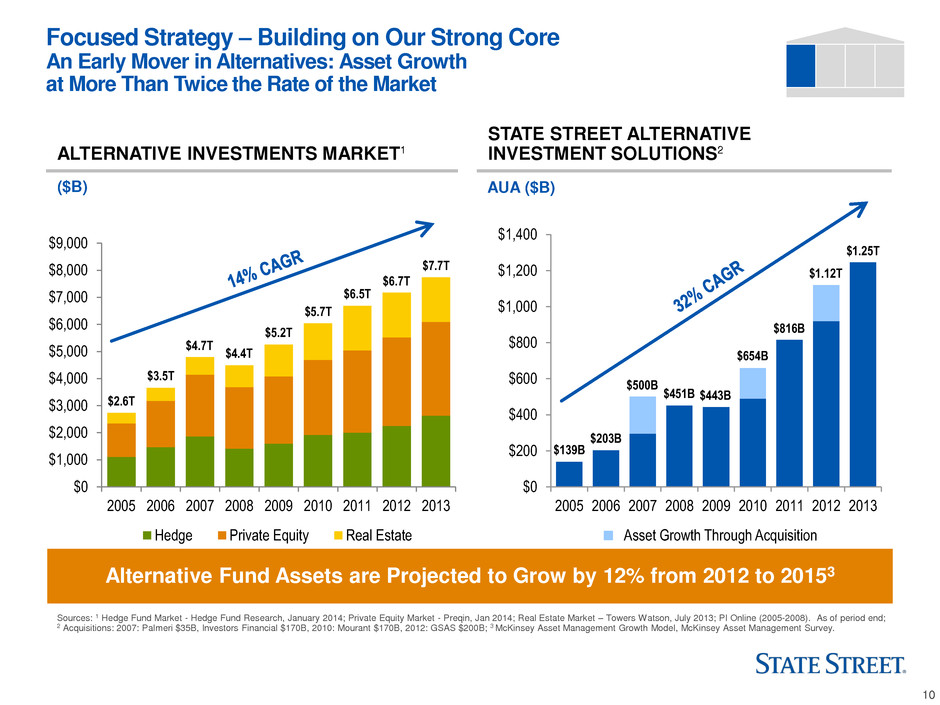
10 Sources: 1 Hedge Fund Market - Hedge Fund Research, January 2014; Private Equity Market - Preqin, Jan 2014; Real Estate Market – Towers Watson, July 2013; PI Online (2005-2008). As of period end; 2 Acquisitions: 2007: Palmeri $35B, Investors Financial $170B, 2010: Mourant $170B, 2012: GSAS $200B; 3 McKinsey Asset Management Growth Model, McKinsey Asset Management Survey. Focused Strategy – Building on Our Strong Core An Early Mover in Alternatives: Asset Growth at More Than Twice the Rate of the Market ALTERNATIVE INVESTMENTS MARKET1 STATE STREET ALTERNATIVE INVESTMENT SOLUTIONS2 AUA ($B) $0 $200 $400 $600 $800 $1,000 $1,200 $1,400 2005 2006 2007 2008 2009 2010 2011 2012 2013 $500B $451B $443B $654B $816B $1.12T $139B $203B $1.25T $0 $1,000 $2,000 $3,000 $4,000 $5,000 $6,000 $7,000 $8,000 $9,000 2005 2006 2007 2008 2009 2010 2011 2012 2013 Hedge Private Equity Real Estate $2.6T $4.7T $3.5T $4.4T $5.7T $5.2T $6.5T $6.7T $7.7T Asset Growth Through Acquisition ($B) Alternative Fund Assets are Projected to Grow by 12% from 2012 to 20153

11 All data as of December 31, 2013, unless otherwise noted. 1This AUM includes the assets of SPDR® Gold ETF (approx. $31B as of December 31, 2013), for which State Street Global Markets, LLC, an affiliate of SSgA, serves as the distribution agent; 2 Includes real estate investment trusts, currency and commodities, including SPDR® Gold ETF for which State Street is not the investment manager, but acts as a distribution agent; 3 Includes both floating- and constant-net- asset-value portfolios held in commingled structures or separate accounts; 4 Assets in multi-asset class solutions are not counted in the underlying asset class; 5 Operating leverage is defined as the rate of growth of total revenue less the rate of growth of total expenses, each as determined on an operating basis; 6 Operating-basis results presented exclude $85 million and $14 million of credits related to gains and recoveries associated with Lehman Brothers-related assets for the years ended December 31, 2013 and 2012, respectively. See Appendix for explanations of our non-GAAP financial measures and for reconciliations of our operating-basis financial information. The Appendix is available on State Street’s website (www.statestreet.com/stockholder) and in State Street’s current report on Form 8-K filed with the SEC on the date hereof. Active, Enhanced, Fundamental, Passive and Multi-Asset Class Solutions Focused Strategy – Building on Our Strong Core SSGA is Well Positioned for Growth • ~3,300 clients globally • ~40% of Top 100 institutions globally • 55% of clients use two or more strategies • 71% of 2013 new business came from existing SSgA clients CLIENTS MARKET LEADERSHIP • 11% management fee revenue growth compared to 2012 • Approximately 200 bps of positive operating leverage5,6, for the year ended December 31, 2013 compared to 2012 • Approximately 130 bps operating margin expansion compared to 20126 STRONG 2013 RESULTS $2.3 TRILLION1 IN ASSETS UNDER MANAGEMENT • No. 2 Global Index Manager • No. 2 ETF Manager • No. 3 Cash Manager Equity $1,376B Multi Asset Class Solutions4 $133B Fixed Income $327B Cash3 $385B Alternative Investments2 $124B

12 $1.1T $1.4T $1.5T $1.9T $2.4T $0.5 $0.7 $0.9 $1.1 $1.3 $1.5 $1.7 $1.9 $2.1 $2.3 $2.5 2009 2010 2011 2012 2013 1 Source: BlackRock ETP Landscape, January 2014. Focused Strategy – Building on Our Strong Core We are a Leading Sponsor of Exchange-Traded Funds SSgA Has Been Successful in Expanding ETF Products to Grow Revenue Yield Powerful Brand ETF AUM (as of March 31, 2014) $387B New Product Introductions (as of Dec 31, 2013) Launched 85 new ETF products since January 2011 at an average total expense ratio of 39bps • North America: 34 • EMEA: 41 • APAC: 10 New ETFs include: • Blackstone/GSO Senior Loan • Ultra Short Term Bond • MFS Actively managed ETF’s • MSCI Beyond BRIC • S&P Global Dividend • Russell Low Volatility ETF’s OUR STRATEGY IS FOCUSED TO GROW REVENUE YIELD GLOBAL MARKET SIZE ETFs/OTHER EXCHANGE-TRADED PRODUCTS1 ($T in assets)

13 Focused Strategy – Business Operations and Information Technology Transformation Program – Achieving a Digital Enterprise Process Automation and Standardization Workforce Optimization: Centers of Excellence Leveraging Lower-Cost Locations Integrating Private Cloud Infrastructure Digital Enterprise • Speed and Agility • Data Services • Increased Efficiency Industry-Leading Platform for Innovation Financial Metrics • Expect to achieve $130M of incremental pre- tax expense savings in 20141 • Expect to achieve $575M-$625M in pre-tax, run-rate expense savings by 20151 1 The full run-rate effect of the pre-tax expense savings is not expected to be achieved until 2015. Data is based on the approximate mid-point of the range of the estimated pre-tax, run-rate expense savings of $575 million to $625 million at the end of 2014, for full effect in 2015. Estimated pre-tax expense savings relate only to the Business Operations and Information Technology Transformation program and are based on projected improvement from total 2010 operating-basis expenses, all else being equal. Actual total expenses of the Company have increased since 2010, and may in the future increase or decrease, due to other factors.
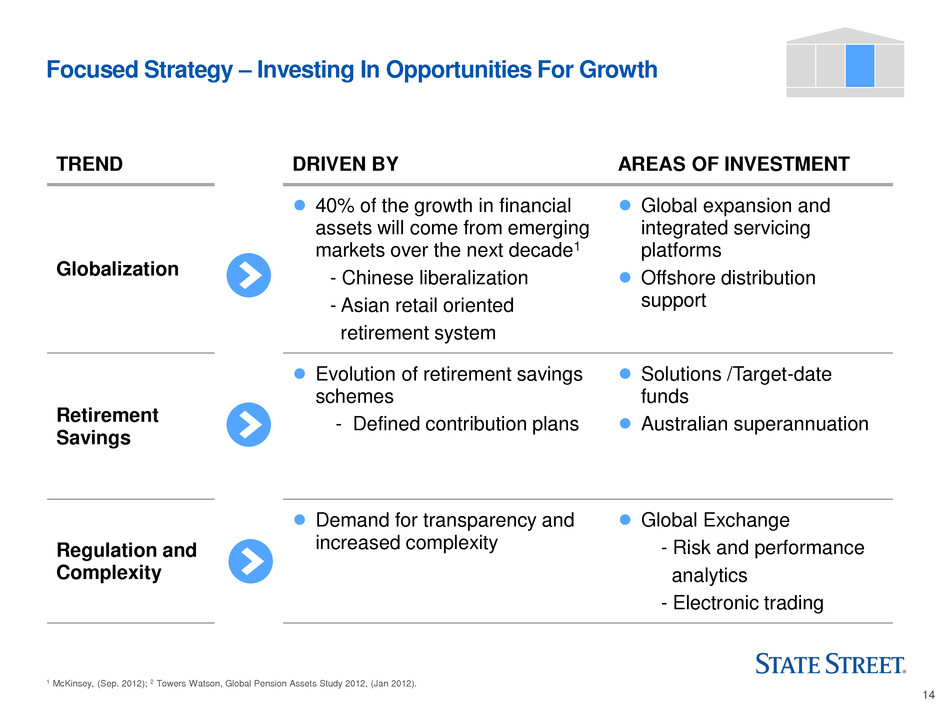
14 1 McKinsey, (Sep. 2012); 2 Towers Watson, Global Pension Assets Study 2012, (Jan 2012). Focused Strategy – Investing In Opportunities For Growth TREND DRIVEN BY AREAS OF INVESTMENT Globalization ● 40% of the growth in financial assets will come from emerging markets over the next decade1 - Chinese liberalization - Asian retail oriented retirement system ● Global expansion and integrated servicing platforms ● Offshore distribution support Retirement Savings ● Evolution of retirement savings schemes - Defined contribution plans ● Solutions /Target-date funds ● Australian superannuation Regulation and Complexity ● Demand for transparency and increased complexity ● Global Exchange - Risk and performance analytics - Electronic trading

15 Focused Strategy – Optimizing Capital INVESTING IN GROWTH RETURNING CAPITAL TO SHAREHOLDERS ● Focus on strategic initiatives – Expanding geographies – New product creation – Advanced technologies ● Optimize capital structure in light of new and emerging rules ● Prioritize return to shareholders through common stock repurchases and dividends ● Target common stock dividends to be 20-25% of operating-basis income1 Balancing Investing in Growth with Shareholder Returns 1 Goals presented on an operating basis, a non-GAAP presentation. See Appendix for explanations of our non-GAAP financial measures and for reconciliations of our operating-basis financial information. The Appendix is available on State Street’s website (www.statestreet.com/stockholder) and in State Street’s current report on Form 8-K filed with the SEC on the date hereof.
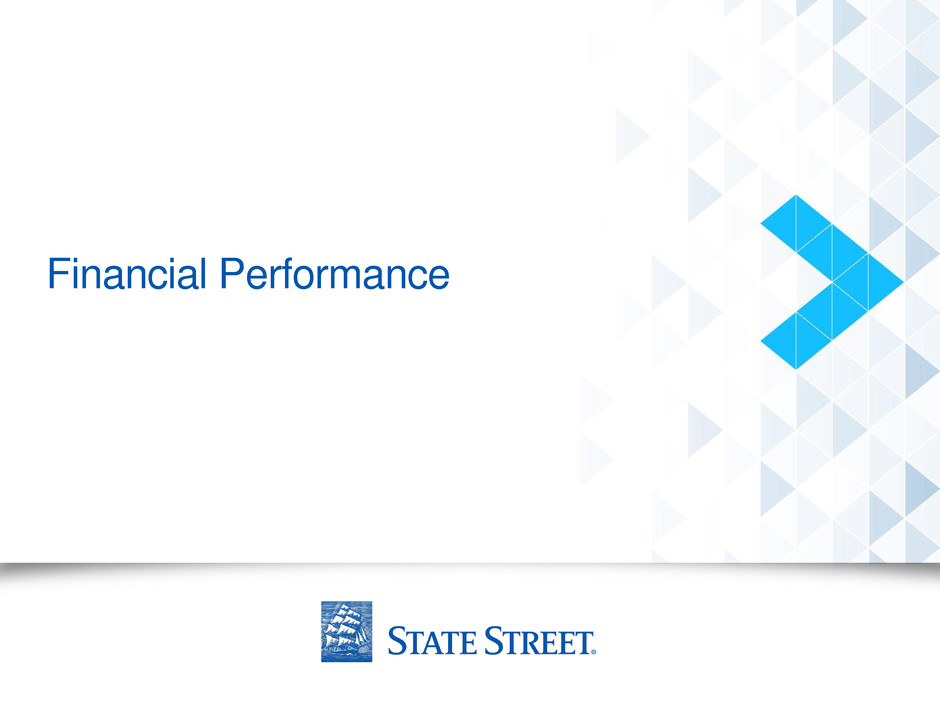
Financial Performance

17 1 Comparisons are to full-year 2012. 2 Results presented on an operating basis, a non-GAAP presentation. See Appendix for explanations of our non-GAAP financial measures and for reconciliations of our operating- basis financial information. The Appendix is available on State Street’s website (www.statestreet.com/stockholder) and in State Street’s current report on Form 8-K filed with the SEC on the date hereof. 3 Estimated pre-tax expense savings relate only to the Business Operations and Information Technology Transformation program and are based on projected improvement from total 2010 operating-basis expenses, all else being equal. Actual total expenses of the Company have increased since 2010, and may in the future increase or decrease, due to other factors. 4 Operating leverage is defined as the rate of growth of total revenue less the rate of growth of total expenses, each as determined on an operating basis. ● Increased operating-basis2 EPS by nearly 15% ● Grew total operating-basis2 revenue 3.3% to more than $10 billion ● Grew core servicing and management fees approximately 10% ● Achieved record levels of $27.4 trillion in assets under custody and administration and $2.35 trillion in assets under management ● Delivered approximately $220 million of incremental pre-tax expense savings3 in connection with our Business Operations and Information Technology Transformation program ● Achieved positive operating leverage4 of 171 basis points ● Returned approximately $2.5 billion in capital in 2013 to our shareholders through common stock repurchases and dividends Financial Performance – 2013 Accomplishments1 Strong Performance Against a Difficult Environment

18 1 (i) Data for each of State Street Corporation (STT), The Bank of New York Mellon Corporation (BK) and Northern Trust Corporation (NTRS) is derived from the relevant company’s public filings, earnings announcements or related materials (individually or collectively, “publicly disclosed information”), (ii) data from the relevant company’s publicly disclosed information is presented on a non-GAAP basis, which presentation is described, at the discretion of the relevant company, in that company’s publicly disclosed information as “operating basis,” “operating,” “adjusted” or “non-GAAP” (individually or collectively, “non-GAAP presentation”); and (iii) each company’s non- GAAP presentation is calculated differently and therefore may not be comparable to other companies’ non-GAAP presentations. Please review each company’s publicly disclosed information for a description, to the extent contained therein, of that company’s non-GAAP presentation. See Appendix for explanations of our non-GAAP financial measures and for reconciliations of our operating-basis financial information. The Appendix is available on State Street’s website (www.statestreet.com/stockholder) and in State Street’s current report on Form 8-K filed with the SEC on the date hereof. Financial Performance – Consistently Outperformed Primary Peers1 (%) (%) (%) PRE-TAX OPERATING MARGIN NET INTEREST MARGIN RETURN ON EQUITY 2 9 .0 2 9 .1 3 0 .1 2 4 .3 2 2 .3 2 4 .4 2 3 .6 2 6 .2 2 6 .9 15 17 19 21 23 25 27 29 31 2011 2012 2013 9 .9 9 .7 1 0 .3 9 .0 8 .8 8 .3 8 .5 9 .3 9 .5 0 2 4 6 8 10 12 2011 2012 2013 1 .5 2 1 .4 6 1 .3 0 1 .3 7 1 .2 1 1 .1 3 1 .2 7 1 .2 2 1 .1 3 0.8 0.9 1.0 1.1 1.2 1.3 1.4 1.5 1.6 2011 2012 2013 STT BK NTRS Well-Positioned to Maintain Our Lead
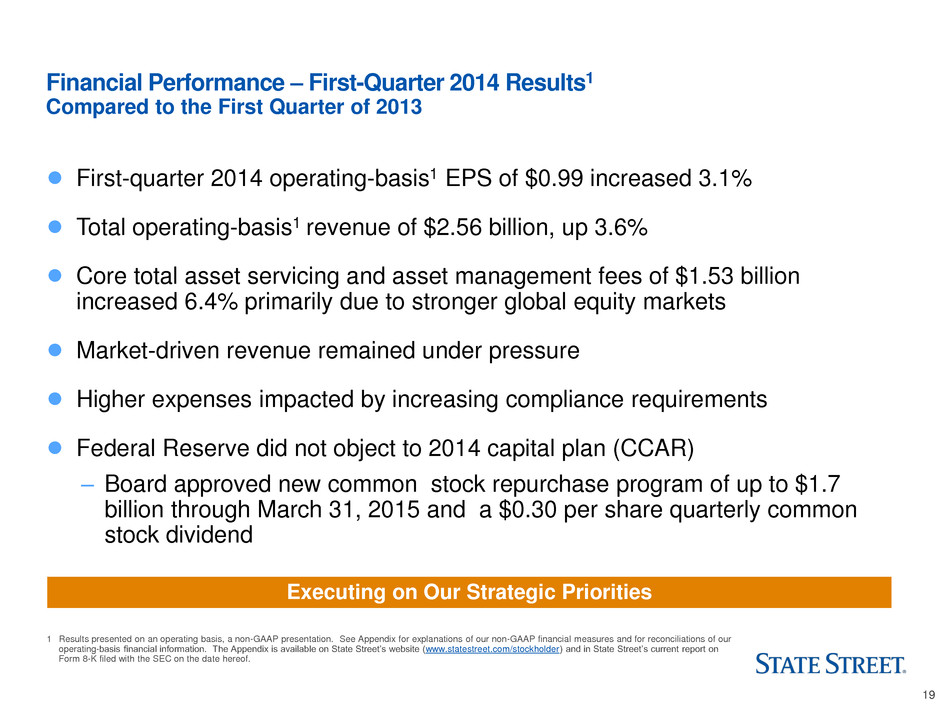
19 1 Results presented on an operating basis, a non-GAAP presentation. See Appendix for explanations of our non-GAAP financial measures and for reconciliations of our operating-basis financial information. The Appendix is available on State Street’s website (www.statestreet.com/stockholder) and in State Street’s current report on Form 8-K filed with the SEC on the date hereof. Compared to the First Quarter of 2013 ● First-quarter 2014 operating-basis1 EPS of $0.99 increased 3.1% ● Total operating-basis1 revenue of $2.56 billion, up 3.6% ● Core total asset servicing and asset management fees of $1.53 billion increased 6.4% primarily due to stronger global equity markets ● Market-driven revenue remained under pressure ● Higher expenses impacted by increasing compliance requirements ● Federal Reserve did not object to 2014 capital plan (CCAR) – Board approved new common stock repurchase program of up to $1.7 billion through March 31, 2015 and a $0.30 per share quarterly common stock dividend Financial Performance – First-Quarter 2014 Results1 Executing on Our Strategic Priorities

20 ● Despite continued headwinds, our outlook for 2014 is positive: – 3-5% operating-basis1 revenue growth compared to 2013 – Targeting positive operating leverage2 – Expect to continue return of capital through quarterly common stock dividends and common stock repurchases ● We are committed to controlling expenses and expect to achieve $130M of incremental pre-tax expense savings3 in 2014 from our Business Operations and IT Transformation program ● We are continuing to invest in growth initiatives ● We are well positioned to deliver shareholder value through our long-term financial objectives 1 Goals presented on an operating basis, a non-GAAP presentation. See Appendix for explanations of our non-GAAP financial measures and for reconciliations of our operating-basis financial information. The Appendix is available on State Street’s website (www.statestreet.com/stockholder) and in State Street’s current report on Form 8-K filed with the SEC on the date hereof. 2 Operating leverage is defined as the rate of growth of total revenue less the rate of growth of total expenses, each as determined on an operating basis. 3 Estimated pre-tax expense savings relate only to the Business Operations and Information Technology Transformation program and are based on projected improvement from total 2010 operating-basis expenses, all else being equal. Actual total expenses of the Company have increased since 2010, and may in the future increase or decrease, due to other factors. Financial Performance – Rest of Year Outlook

Summary

22 1 Goals presented on an operating basis, a non-GAAP presentation. See Appendix for explanations of our non-GAAP financial measures and for reconciliations of our operating-basis financial information. The Appendix is available on State Street’s website (www.statestreet.com/stockholder) and in State Street’s current report on Form 8-K filed with the SEC on the date hereof. Focused Strategy LONG-TERM SHAREHOLDER VALUE Operating-Basis1 Financial Goals: EPS Growth of 10%-15%, Revenue Growth of 8%-12% and ROE of 12%-15% BUILDING ON OUR STRONG CORE ACHIEVING A DIGITAL ENTERPRISE INVESTING IN OPPORTUNITIES FOR GROWTH OPTIMIZING CAPITAL Aligning solutions with client needs, continuing to innovate, capturing value and improving efficiency Driving greater transformation that benefits clients and our shareholders Acting on changes in the market to fuel expansion of products and services and the markets we serve Adapting to new rules and optimizing returns for shareholders TALENT, CULTURE AND INNOVATION
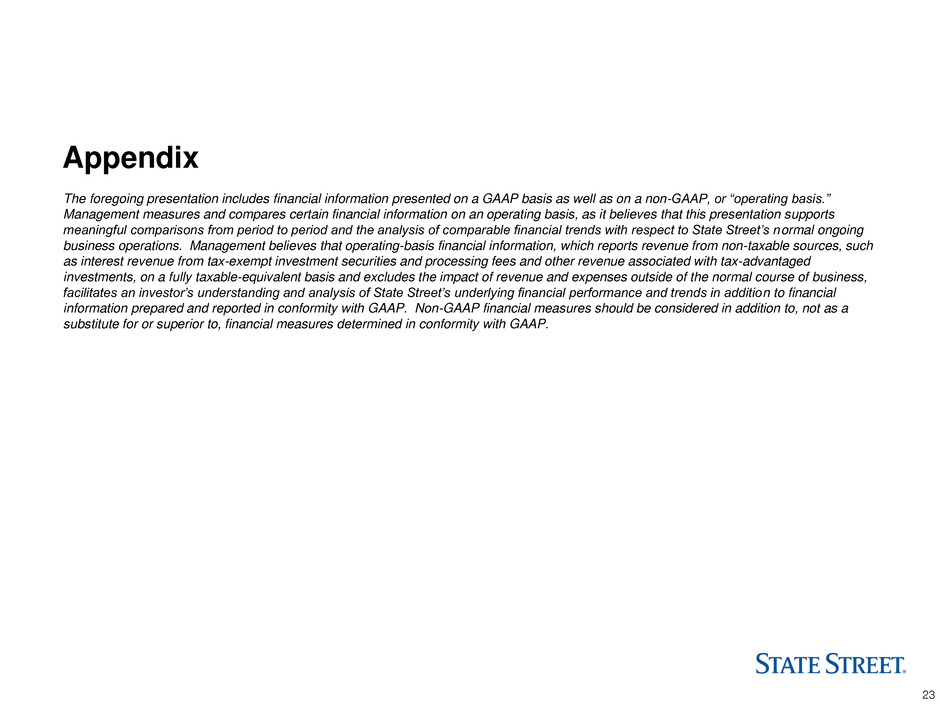
23 Appendix The foregoing presentation includes financial information presented on a GAAP basis as well as on a non-GAAP, or “operating basis.” Management measures and compares certain financial information on an operating basis, as it believes that this presentation supports meaningful comparisons from period to period and the analysis of comparable financial trends with respect to State Street’s normal ongoing business operations. Management believes that operating-basis financial information, which reports revenue from non-taxable sources, such as interest revenue from tax-exempt investment securities and processing fees and other revenue associated with tax-advantaged investments, on a fully taxable-equivalent basis and excludes the impact of revenue and expenses outside of the normal course of business, facilitates an investor’s understanding and analysis of State Street’s underlying financial performance and trends in addition to financial information prepared and reported in conformity with GAAP. Non-GAAP financial measures should be considered in addition to, not as a substitute for or superior to, financial measures determined in conformity with GAAP.
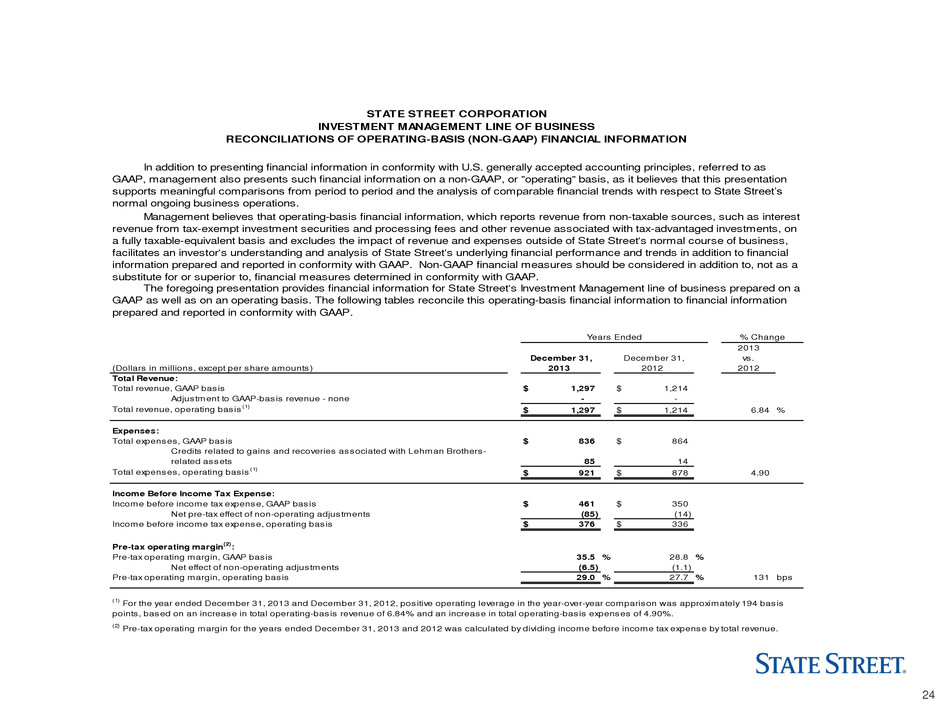
24 2013 vs. (Dollars in millions, except per share amounts) 2012 Total Revenue: Total revenue, GAAP basis $ 1,297 $ 1,214 Adjustment to GAAP-basis revenue - none - - Total revenue, operating basis (1) $ 1,297 $ 1,214 6.84 % Expenses: Total expenses, GAAP basis $ 836 $ 864 Credits related to gains and recoveries associated with Lehman Brothers- related assets 85 14 Total expenses, operating basis (1) $ 921 $ 878 4.90 Income Before Income Tax Expense: Income before income tax expense, GAAP basis $ 461 $ 350 Net pre-tax effect of non-operating adjustments (85) (14) Income before income tax expense, operating basis $ 376 $ 336 Pre-tax operating margin (2) : Pre-tax operating margin, GAAP basis 35.5 % 28.8 % Net effect of non-operating adjustments (6.5) (1.1) Pre-tax operating margin, operating basis 29.0 % 27.7 % 131 bps 2013 2012 (1) For the year ended December 31, 2013 and December 31, 2012, positive operating leverage in the year-over-year comparison was approximately 194 basis points, based on an increase in total operating-basis revenue of 6.84% and an increase in total operating-basis expenses of 4.90%. (2) Pre-tax operating margin for the years ended December 31, 2013 and 2012 was calculated by dividing income before income tax expense by total revenue. December 31, December 31, STATE STREET CORPORATION INVESTMENT MANAGEMENT LINE OF BUSINESS RECONCILIATIONS OF OPERATING-BASIS (NON-GAAP) FINANCIAL INFORMATION In addition to presenting financial information in conformity with U.S. generally accepted accounting principles, referred to as GAAP, management also presents such financial information on a non-GAAP, or "operating" basis, as it believes that this presentation supports meaningful comparisons from period to period and the analysis of comparable financial trends with respect to State Street’s normal ongoing business operations. Management believes that operating-basis financial information, which reports revenue from non-taxable sources, such as interest revenue from tax-exempt investment securities and processing fees and other revenue associated with tax-advantaged investments, on a fully taxable-equivalent basis and excludes the impact of revenue and expenses outside of State Street's normal course of business, facilitates an investor's understanding and analysis of State Street's underlying financial performance and trends in addition to financial information prepared and reported in conformity with GAAP. Non-GAAP financial measures should be considered in addition to, not as a substitute for or superior to, financial measures determined in conformity with GAAP. The foregoing presentation provides financial information for State Street's Investment Management line of business prepared on a GAAP as well as on an operating basis. The following tables reconcile this operating-basis financial information to financial information prepared and reported in conformity with GAAP. Years Ended % Change

25 2013 vs. (Dollars in millions) 2012 Total Revenue: Total revenue, GAAP basis $ 9,884 $ 9,649 2.4 % Tax-equivalent adjustment associated with tax-exempt investment securities 142 124 Tax-equivalent adjustment associated with tax-advantaged investments 158 126 Loss on sale of Greek investment securities - 46 Discount accretion associated with former conduit securities (137) (215) Total revenue, operating basis (1) $ 10,047 $ 9,730 3.26 Expenses: Total expenses, GAAP basis $ 7,192 $ 6,886 4.4 Severance costs associated with reorganization of certain non-U.S. operations (11) - Benefit associated with claims associated with Lehman bankruptcy - 362 Provisions for litigation exposure and other costs (65) (93) Special one-time additional charitable contribution - (25) Acquisition costs (76) (66) Restructuring charges, net (28) (199) Indemnification benefit for the assumption of an income tax liability associated with 2010 acquistion - 40 Total expenses, operating basis (1) $ 7,012 $ 6,905 1.55 Diluted Earnings per Common Share: Diluted earnings per common share, GAAP basis $ 4.62 $ 4.20 10.0 Loss on sale of Greek investment securities - .06 Severance costs associated with reorganization of certain non-U.S. operations .02 - Benefit associated with claims associated with Lehman bankruptcy - (.46) Provisions for litigation exposure and other costs .09 .12 Special one-time additional charitable donation - .04 Acquisition costs .11 .09 Restructuring charges, net .04 .27 Discount accretion associated with former conduit securities (.18) (.27) Out-of-period income tax benefit to adjust deferred taxes (.16) - Net tax effect of audit settlements associated with 2010 acquisition - (.10) Diluted earnings per common share, operating basis $ 4.54 $ 3.95 14.9 December 31, December 31, STATE STREET CORPORATION RECONCILIATIONS OF OPERATING-BASIS (NON-GAAP) FINANCIAL INFORMATION In addition to presenting State Street’s financial results in conformity with U.S. generally accepted accounting principles, referred to as GAAP, management also presents results on a non-GAAP, or "operating" basis, as it believes that this presentation supports meaningful comparisons from period to period and the analysis of comparable financial trends with respect to State Street’s normal ongoing business operations. Management believes that operating-basis financial information, which reports revenue from non-taxable sources, such as interest revenue from tax-exempt investment securities and processing fees and other revenue associated with tax-advantaged investments, on a fully taxable-equivalent basis and excludes the impact of revenue and expenses outside of State Street's normal course of business, facilitates an investor's understanding and analysis of State Street's underlying financial performance and trends in addition to financial information prepared and reported in conformity with GAAP. Non-GAAP financial measures should be considered in addition to, not as a substitute for or superior to, financial measures determined in conformity with GAAP. The foregoing presentation provides State Street's financial results prepared on a GAAP as well as on an operating basis. The following tables reconcile this operating-basis financial information to financial information prepared and reported in conformity with GAAP. Years Ended % Change (1) For the year ended December 31, 2013 and December 31, 2012, positive operating leverage in the year-over-year comparison was approximately 171 basis points, based on an increase in total operating-basis revenue of 3.26% and an increase in total operating-basis expenses of 1.55%. 2013 2012

26 (Dollars in millions, except per share amounts) Income Before Income Tax Expense: Income before income tax expense, GAAP basis $ 2,686 $ 2,766 $ 2,536 Net pre-tax effect of non-operating adjustments to revenue and expenses 343 62 239 Income before income tax expense, operating basis $ 3,029 $ 2,828 $ 2,775 Pre-tax operating margin (1) : Pre-tax operating margin, GAAP basis 27.2 % 28.7 % 26.4 % Net effect of non-operating adjustments 2.9 0.4 2.6 Pre-tax operating margin, operating basis 30.1 % 29.1 % 29.0 % Net Interest Revenue: Net interest revenue, GAAP basis $ 2,303 $ 2,538 $ 2,333 Tax-equivalent adjustment associated with tax-exempt investment securities 142 124 128 Discount accretion associated with former conduit securities (137) (215) (220) Net interest revenue, operating basis $ 2,308 $ 2,447 $ 2,241 Net Interest Margin: Net interest margin, fully taxable-equivalent basis (2) 1.37 % 1.59 % 1.67 % Effect of discount accretion (0.07) (0.13) (0.15) Net interest margin, operating basis 1.30 % 1.46 % 1.52 % Return on Average Common Equity: Return on average common equity, GAAP basis 10.5 % 10.3 % 10.0 % Loss on sale of Greek investment securities - .1 - Benefit associated with claims associated with Lehman bankruptcy - (1.1) - Provisions for litigation exposure and other costs .2 .3 - Special one-time additional charitable donation - .1 - Acquisition costs .3 .2 .3 Restructuring charges, net .1 .7 .8 Discount accretion associated with former conduit securities (.4) (.7) (.7) Out-of-period income tax benefit to adjust deferred taxes (.4) - - Net tax effect of audit settlements associated with 2010 acquisition - (.2) - Discrete tax benefit associated with former conduit securities - - (.5) Return on average common equity, operating basis 10.3 % 9.7 % 9.9 % STATE STREET CORPORATION RECONCILIATIONS OF OPERATING-BASIS (NON-GAAP) FINANCIAL INFORMATION In addition to presenting State Street’s financial results in conformity with U.S. generally accepted accounting principles, referred to as GAAP, management also presents results on a non-GAAP, or "operating" basis, as it believes that this presentation supports meaningful comparisons from period to period and the analysis of comparable financial trends with respect to State Street’s normal ongoing business operations. 2013 2012 2011 Management believes that operating-basis financial information, which reports revenue from non-taxable sources, such as interest revenue from tax-exempt investment securities and processing fees and other revenue associated with tax-advantaged investments, on a fully taxable-equivalent basis and excludes the impact of revenue and expenses outside of State Street's normal course of business, facilitates an investor's understanding and analysis of State Street's underlying financial performance and trends in addition to financial information prepared and reported in conformity with GAAP. Non-GAAP financial measures should be considered in addition to, not as a substitute for or superior to, financial measures determined in conformity with GAAP. (2) For the years ended December 31, 2013, 2012, and 2011, fully taxable-equivalent net interest margin represented fully taxable-equivalent net interest revenue of $2,445 million, $2,662 million and $2,461 million, respectively (GAAP-basis net interest revenue of $2,303 million, $2,538 million and $2,333 million plus tax- equivalent adjustments of $142 million, $124 million and $128 million, respectively), as a percentage of average total interest-earning assets for the periods presented. The foregoing presentation provides State Street's financial results prepared on a GAAP as well as on an operating basis. The following tables reconcile this operating-basis financial information to financial information prepared and reported in conformity with GAAP. Years Ended (1) Pre-tax operating margin for the years ended December 31, 2013, 2012 and 2011 was calculated by dividing income before income tax expense by total revenue. December 31, December 31, December 31,

27 Q1 2014 vs. (Dollars in millions) Q1 2013 Total Revenue: Total revenue, GAAP basis $ 2,485 $ 2,435 2.1 % Tax-equivalent adjustment associated with tax-advantaged investments 57 34 Tax-equivalent adjustment associated with tax-exempt investment securities 44 32 Discount accretion associated with former conduit securities (27) (31) Total revenue, operating basis $ 2,559 $ 2,470 3.6 Diluted Earnings per Common Share: Diluted earnings per common share, GAAP basis $ .81 $ .98 (17.3) Severance costs .11 - Provisions for litigation exposure and other costs, net .01 - Acquisition costs .03 .02 Restructuring charges .02 - Effect of income tax rate of non-operating adjustments .02 - Discount accretion associated with former conduit securities (.04) (.04) Italian banking industry tax assessment .03 - Diluted earnings per common share, operating basis $ .99 $ .96 3.1 March 31, 2013 March 31, 2014 STATE STREET CORPORATION RECONCILIATIONS OF OPERATING-BASIS (NON-GAAP) FINANCIAL INFORMATION In addition to presenting State Street’s financial results in conformity with U.S. generally accepted accounting principles, referred to as GAAP, management also presents results on a non-GAAP, or "operating" basis, as it believes that this presentation supports meaningful comparisons from period to period and the analysis of comparable financial trends with respect to State Street’s normal ongoing business operations. % Change The foregoing presentation provides State Street's financial results prepared on a GAAP as well as on an operating basis. The following tables reconcile this operating-basis financial information to financial information prepared and reported in conformity with GAAP. Management believes that operating-basis financial information, which reports revenue from non-taxable sources, such as interest revenue from tax-exempt investment securities and processing fees and other revenue associated with tax-advantaged investments, on a fully taxable-equivalent basis and excludes the impact of revenue and expenses outside of State Street's normal course of business, facilitates an investor's understanding and analysis of State Street's underlying financial performance and trends in addition to financial information prepared and reported in conformity with GAAP. Non-GAAP financial measures should be considered in addition to, not as a substitute for or superior to, financial measures determined in conformity with GAAP. Quarters Ended
